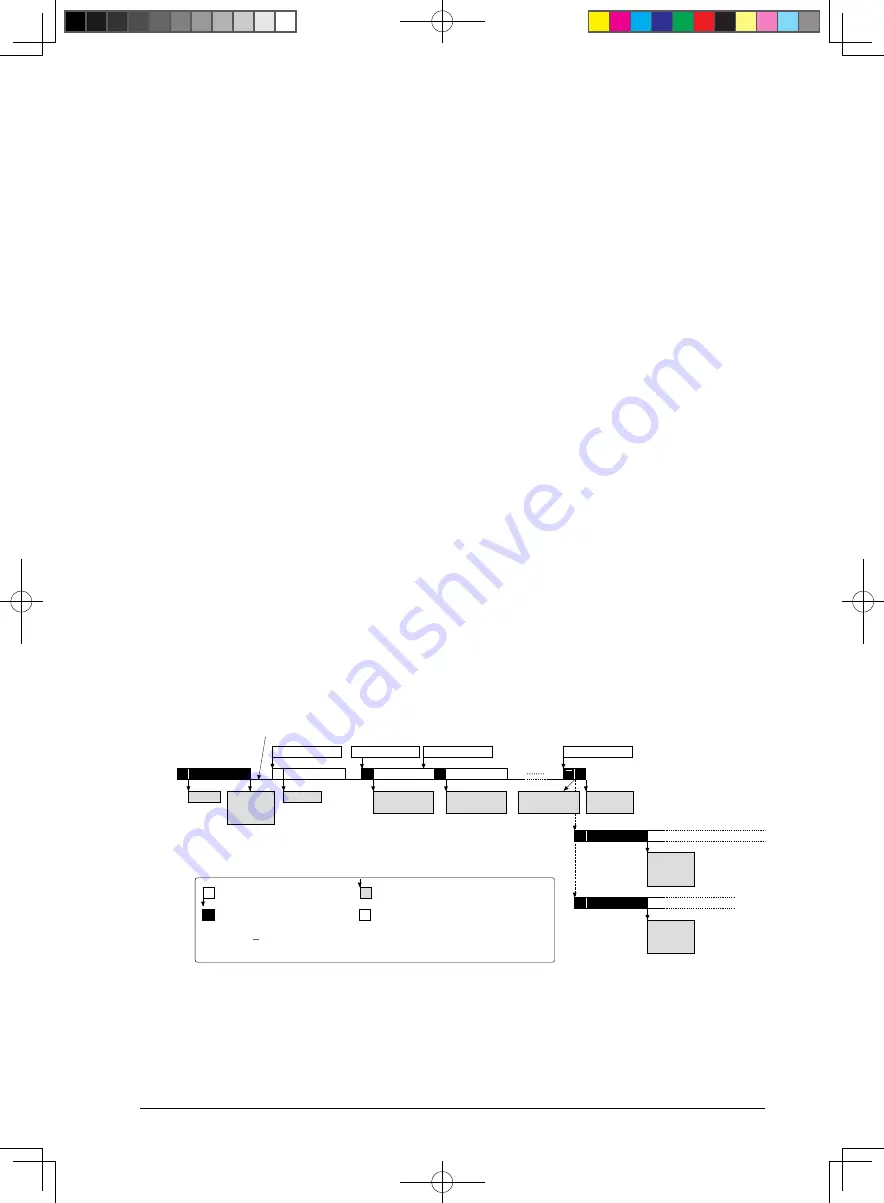
12 I
2
C (I2C)
S1C17F13 TeChniCal Manual
Seiko epson Corporation
12-11
(Rev. 1.0)
Data sending operations
START condition detection and slave address check
While the I2C
n
CTL.MODEN bit = 1 and the I2C
n
CTL.MST bit = 0 (slave mode), the I2C Ch.
n
monitors
the I
2
C bus. When the I2C Ch.
n
detects a START condition, it starts receiving of the slave address sent from
the master. If the received address is matched with the own address set to the I2C
n
OADR.OADR[6:0] bits
(when the I2C
n
MOD.OADR10 bit = 0 (7-bit address mode)) or the I2C
n
OADR.OADR[9:0] bits (when the
I2C
n
MOD.OADR10 bit = 1 (10-bit address mode)), the I2C
n
INTF.STARTIF bit and the I2C
n
INTF.BSY bit
are both set to 1. The I2C Ch.
n
sets the I2C
n
INTF.TR bit to the R/W bit value in the received address. If this
value is 1, the I2C Ch.
n
sets the I2C
n
INTF.TBEIF bit to 1 and starts data sending operations.
Sending the first data byte
After the valid slave address has been received, the I2C Ch.
n
pulls down SCL to low and enters standby
state until data is written to the I2C
n
TXD register. This puts the I
2
C bus into clock stretching state and the
external master into standby state. When transmit data is written to the I2C
n
TXD register, the I2C Ch.
n
clears the I2C
n
INTF.TBEIF bit and sends an ACK to the master. The transmit data written in the I2C
n
TXD
register is automatically transferred to the shift register and the I2C
n
INTF.TBEIF bit is set to 1. The data
bits in the shift register are output in sequence to the I
2
C bus.
Sending subsequent data
If the I2C
n
INTF.TBEIF bit = 1, subsequent transmit data can be written during data transmission. If the
I2C
n
INTF.TBEIF bit is still set to 1 when the data transmission from the shift register has completed, the I2C
Ch.
n
pulls down SCL to low (sets the I
2
C bus into clock stretching state) until transmit data is written to the
I2C
n
TXD register.
If the next transmit data already exists in the I2C
n
TXD register or data has been written after the above,
the I2C Ch.
n
sends the subsequent eight-bit data when an ACK from the external master is received. At the
same time, the I2C
n
INTF.BYTEENDIF bit is set to 1. If a NACK is received, the I2C
n
INTF.NACKIF bit is
set to 1 without sending data.
STOP/repeated START condition detection
While the I2C
n
CTL.MST bit = 0 (slave mode) and the I2C
n
INTF.BSY = 1, the I2C Ch.
n
monitors the I
2
C
bus. When the I2C Ch.
n
detects a STOP condition, it terminates data sending operations. At this time, the
I2C
n
INTF.BSY bit is cleared to 0 and the I2C
n
INTF.STOPIF bit is set to 1. Also when the I2C Ch.
n
detects a
repeated START condition, it terminates data sending operations. In this case, the I2C
n
INTF.STARTIF bit is
set to 1.
S
P
A
TBEIF = 1
TBEIF = 1
BYTEENDIF = 1
TBEIF = 1
BYTEENDIF = 1
BSY = 0
STOPIF = 1
Saddr/R
A
Data 1
A
Data 2
A
Data 3
I
2
C bus
Clock stretching by I2C
BSY = 1
STARTIF = 1
TBEIF = 1
NACKIF = 1
BYTEENDIF = 1
Sr
Saddr/R
TR = 0
BSY = 1
STARTIF = 1
Sr
Saddr/W
Data 1
→
TXD[7:0]
Data 2
→
TXD[7:0] Data 3
→
TXD[7:0]
Data N
→
TXD[7:0]
Data transmission continued
Data reception starts
Software bit operations
Operations by the external master
S: START condition, Sr: Repeated START condition, P: STOP condition,
A: ACK, A: NACK, Saddr/R: Slave a R(1), Saddr/W: Slave a W(0),
Data
n
: 8-bit data
Hardware bit operations
Operations by I2C (slave mode)
TR = 1
STARTIF = 1
TBEIF = 1
BSY = 1
4.5.1 Example of Data Sending Operations in Slave Mode
Figure 12.
















































